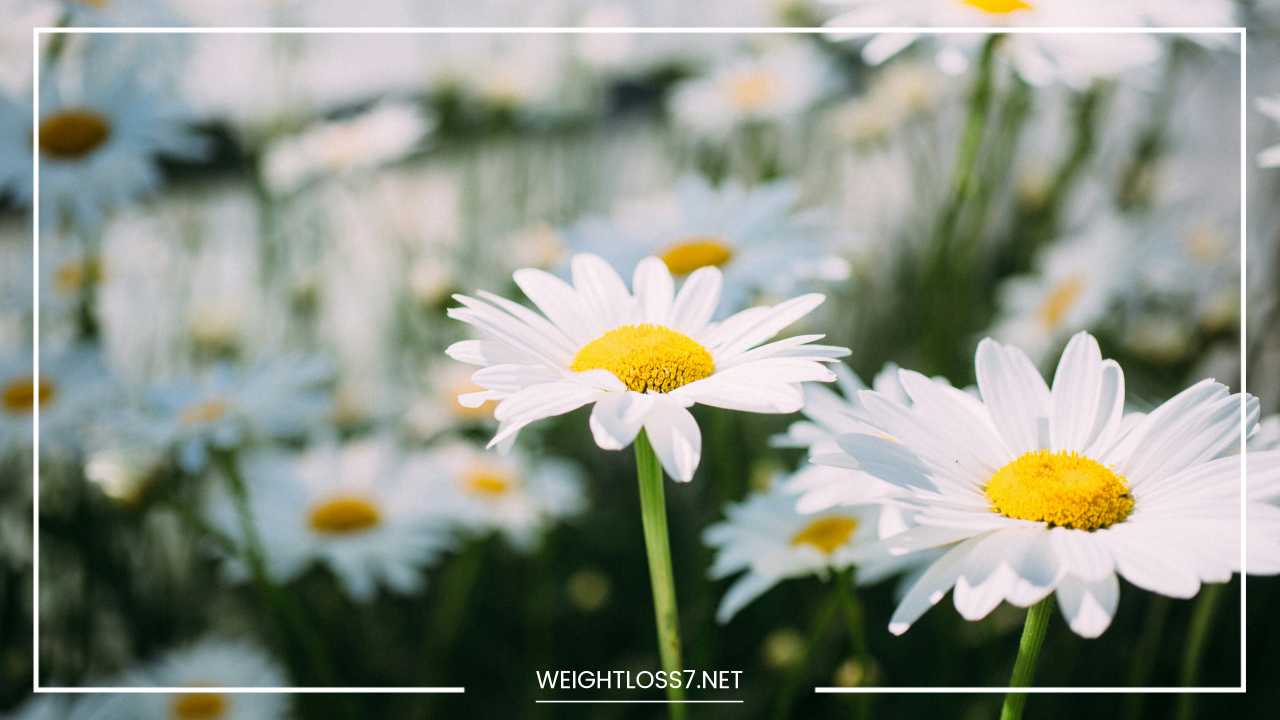Chamomile Uses and Health Benefits

Chamomile
Chamomile Uses and Health Benefits: A Soothing Herb for Mind and Body
Chamomile, a delicate daisy-like flower with a sweet, apple-like aroma, boasts a rich history as a medicinal herb.
Traced back to ancient civilizations, chamomile has transcended cultures and time, gracing everything from Egyptian remedies to European bedtime rituals.
Today, this versatile herb continues to be a popular choice for promoting relaxation, soothing digestive woes, and calming the skin.
This comprehensive guide dives deep into the world of chamomile, exploring its historical significance, delving into the science behind its potential health benefits, and offering practical ways to incorporate it into your wellness routine.
A Journey Through Time: Chamomile’s Enduring Legacy
The use of chamomile stretches back millennia, leaving its mark on various cultures. Evidence suggests Egyptians employed chamomile for wound healing and digestive issues as early as 1500 BC.
Ancient Greek texts authored by physicians like Dioscorides mention chamomile’s calming properties and its use for feminine health concerns. Similarly, traditional Chinese medicine incorporated chamomile into their practices for centuries.
As the world became more interconnected, chamomile’s popularity spread. By the Middle Ages, chamomile tea became a staple in European households.
Its calming properties were particularly valued, making it a go-to beverage for promoting relaxation and restful sleep. Over time, chamomile transcended cultures and social classes, becoming a widely recognized and appreciated herb.
Science Unveils the Secrets of Chamomile
While historical uses of chamomile often stemmed from tradition and anecdotal evidence, modern scientific research is shedding light on the potential reasons behind these practices. Here’s a closer look at some key areas where science is exploring chamomile’s potential benefits:
-
Relaxation and Sleep: One of chamomile’s most well-known benefits is its ability to promote relaxation and sleep. Studies suggest that apigenin, a flavonoid abundant in chamomile, may interact with specific brain receptors that play a role in sleep and calmness. Apigenin is thought to bind to these receptors, promoting the release of certain calming neurotransmitters, ultimately leading to feelings of relaxation and sleepiness. Chamomile tea is a popular natural remedy for those struggling with insomnia or anxiety-related sleep disturbances.
-
Digestive Relief: Chamomile possesses a unique combination of anti-inflammatory and spasmolytic properties. These properties may help alleviate digestive discomfort by reducing inflammation in the gut and relaxing smooth muscle contractions. This can be beneficial for those experiencing symptoms like nausea, indigestion, and stomach cramps. Drinking chamomile tea or taking a chamomile supplement may provide relief for mild digestive issues.
-
Skin Soothing: Chamomile’s anti-inflammatory properties extend beyond the gut, offering potential benefits for various skin conditions. Studies suggest that chamomile may help alleviate symptoms of eczema and psoriasis by reducing inflammation and irritation. Additionally, chamomile’s antimicrobial properties may contribute to wound healing and prevent infections. Chamomile-infused creams, lotions, or salves can offer soothing relief for irritated, inflamed skin.
-
Wound Healing: Research is ongoing into chamomile’s potential to promote wound healing. Some studies suggest that chamomile extracts may accelerate wound closure and reduce inflammation. Chamomile’s potential antimicrobial properties may also contribute to faster healing by preventing infections in wounds. However, more research is required to determine the effectiveness of chamomile for wound healing purposes and establish the most appropriate application methods.
-
Other Potential Benefits: The world of chamomile research is vast and ever-evolving. Scientists are exploring chamomile’s potential effects on various other health conditions, including anxiety, menstrual cramps, blood sugar control, and even certain types of cancer. While some results are promising, more studies are needed to confirm these benefits and understand the mechanisms behind them.
Chamomile: A Versatile Herb in Many Forms
The beauty of chamomile lies in its versatility. It’s available in various forms to suit your needs and preferences:
-
Chamomile Tea: The most popular way to consume chamomile is as a tea. Simply steep dried chamomile flowers in hot water for 5-10 minutes to create a calming and flavorful beverage. For enhanced taste, consider adding honey, lemon, or other herbs like mint or lavender.
-
Chamomile Tincture: A concentrated liquid extract of chamomile, tinctures offer a potent dose of the herb. Chamomile tinctures can be diluted in water or juice before consumption.
-
Chamomile Supplements: Chamomile capsules or tablets offer a convenient way to consume the herb, particularly for those who dislike the taste of chamomile tea.
-
Chamomile Essential Oil: While chamomile essential oil is not recommended for internal use, it can be enjoyed through aromatherapy. Dilute a few drops of chamomile essential oil with a carrier oil like almond oil or jojoba oil before applying it topically to the skin or diffusing it using an essential oil diffuser. Inhaled chamomile essential oil may promote relaxation and improve sleep quality.
-
Chamomile Lotions and Creams: Topical formulations allow for localized application of chamomile’s benefits. Look for chamomile-infused lotions, creams, or salves to soothe irritated skin, reduce inflammation, and promote healing for conditions like eczema and psoriasis. These products can also be helpful for calming sunburns or minor skin irritations.
Safe and Effective Use of Chamomile
While chamomile is generally safe for most people, it’s important to be mindful of potential side effects and interactions:
-
Allergic Reactions: People with allergies to ragweed or other daisy-like plants may experience allergic reactions to chamomile. Symptoms can include rash, itching, swelling, or difficulty breathing. If you experience any allergic reactions after using chamomile, discontinue use immediately and consult a healthcare professional.
-
Medications: Chamomile may interact with certain medications, such as blood thinners and sedatives. Chamomile’s sedative properties may enhance the effects of these medications, potentially leading to excessive drowsiness or other side effects. Consult your doctor before using chamomile if you are taking any medications to ensure there are no potential interactions.
-
Pregnancy and Breastfeeding: The safety of chamomile during pregnancy and breastfeeding is not fully established. Limited research suggests it may be generally safe, but it’s always best to consult your doctor before using chamomile if you are pregnant or breastfeeding.
Brewing a Cup of Calm: Practical Tips for Using Chamomile
Now that you’ve explored the history, science, and various forms of chamomile, let’s delve into practical ways to incorporate it into your wellness routine:
-
Relaxation Ritual: Steep a cup of chamomile tea 30-60 minutes before bedtime to promote relaxation and prepare your body for sleep. The calming properties of chamomile can help ease anxiety and quiet the mind, making it easier to drift off to sleep.
-
Soothing Digestion: If you’re experiencing mild digestive discomfort like nausea, indigestion, or stomach cramps, consider drinking a cup of chamomile tea after meals. Chamomile’s anti-inflammatory and spasmolytic properties may help alleviate these symptoms and promote smoother digestion.
-
Calming Skin: For irritated or inflamed skin, a chamomile compress can provide soothing relief. Steep chamomile flowers in hot water to create a strong tea, then allow it to cool slightly. Soak a clean washcloth in the cooled tea and apply it to the affected area for 10-15 minutes. Repeat this process as needed throughout the day.
-
Aromatherapy Bath: Create a relaxing and restorative bath experience by adding a few drops of diluted chamomile essential oil to your bathwater. The inhaled aroma of chamomile can promote relaxation and ease tension, while the warm bath water soothes sore muscles and promotes circulation.
Remember:
- Chamomile is not a replacement for medical treatment. If you are experiencing any chronic or severe health concerns, consult your doctor for proper diagnosis and treatment.
- It’s always best to start with a low dose of chamomile, particularly if you’re new to using it. Monitor your body’s response and adjust the dosage as needed.
- If you experience any side effects after using chamomile, discontinue use immediately and consult a healthcare professional.
Chamomile’s gentle and versatile nature positions it as a valuable addition to your natural wellness toolkit. From promoting relaxation and sleep to soothing digestive woes and calming irritated skin, chamomile offers a natural approach to support your well-being. So, steep a cup of chamomile tea, breathe in its calming aroma, and experience the tranquility this ancient herb has to offer.
Beyond the Basics: Exploring Chamomile’s Additional Facets
While the core aspects of chamomile have been covered, this versatile herb offers even more to explore. Let’s delve into some additional facets of chamomile, including interesting trivia, potential interactions with other herbs, and considerations for sustainable sourcing.
Chamomile: A Botanical Duo
Did you know there are actually two main types of chamomile commonly used for medicinal purposes? These are:
-
German Chamomile (Matricaria recutita): This is the most widely used variety and is often referred to simply as “chamomile.” German chamomile is known for its small, daisy-like flowers with white petals and yellow centers. It possesses the calming and anti-inflammatory properties most commonly associated with chamomile.
-
Roman Chamomile (Chamaemelum nobile): Roman chamomile has larger flowers with white petals and golden yellow centers. It offers a sweeter aroma compared to German chamomile and is often used in cosmetic products and aromatherapy due to its pleasant scent. While Roman chamomile may also possess some relaxing properties, research suggests it may be less potent than German chamomile in this regard [12].
Chamomile and Other Herbs: A Synergy of Benefits
Chamomile can be a wonderful complement to other herbs, creating a synergistic effect to enhance overall benefits. Here are some interesting combinations to consider:
-
Chamomile and Lavender: Both chamomile and lavender are renowned for their calming properties. Combining them in a tea or aromatherapy blend can create a powerful relaxation synergy, perfect for unwinding before bed or easing anxiety [13].
-
Chamomile and Peppermint: While chamomile soothes digestion, peppermint is known for its ability to relieve nausea and bloating. Combining these herbs in a tea can be particularly helpful for those experiencing digestive discomfort [14].
-
Chamomile and Echinacea: Chamomile’s anti-inflammatory properties may be complemented by echinacea’s immune-boosting effects. This combination may be beneficial for those experiencing a cold or flu, helping to soothe symptoms and potentially shorten recovery time [15].
Sustainable Sourcing: Choosing Chamomile Wisely
Chamomile is a popular herb, and with growing demand, it’s important to consider sustainable sourcing practices. Here are some tips for choosing chamomile with an eco-conscious approach:
-
Look for organic chamomile: Opting for organic chamomile helps ensure the herb is grown without harmful pesticides or chemicals, promoting a healthier environment.
-
Support local farms: Purchasing chamomile from local farms that practice sustainable agriculture not only reduces your carbon footprint but also supports local businesses.
-
Grow your own chamomile: If you have the space and interest, consider growing your own chamomile. This allows you to control the entire process, ensuring organic practices and a readily available supply of fresh chamomile.
Final Word: Chamomile – A Timeless Herb for Modern Wellness
Chamomile’s journey from ancient remedies to modern wellness practices is a testament to its enduring value. Science continues to explore the potential benefits of this gentle herb, offering a natural approach to promoting relaxation, sleep, digestion, and skin health.
With its versatility and ease of use, chamomile can be a valuable addition to your natural wellness toolkit. So, embrace the tranquility of chamomile, explore its different forms and applications, and embark on a journey towards holistic well-being.
Disclaimer: This blog post is for informational purposes only and should not be construed as medical advice. Please consult with a qualified healthcare professional before using chamomile or any other herbal remedy.

















